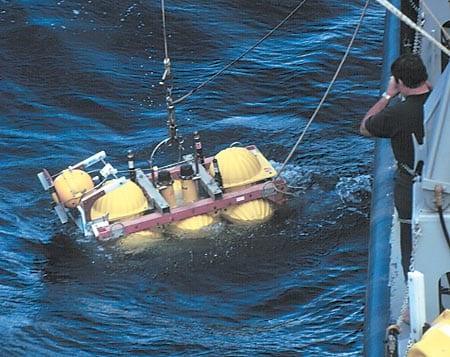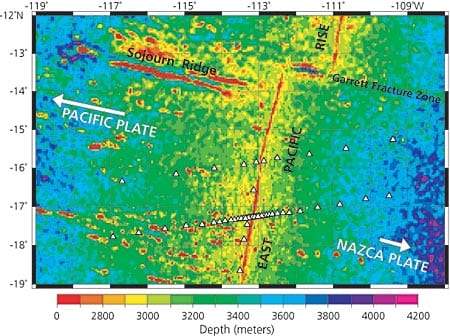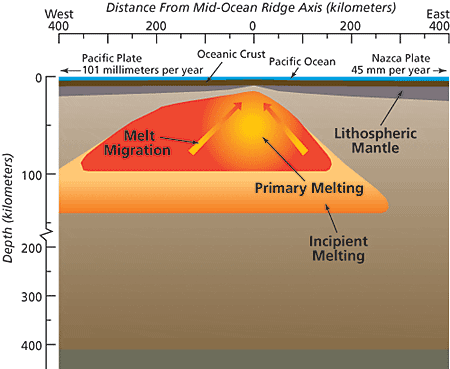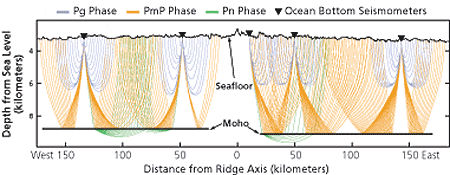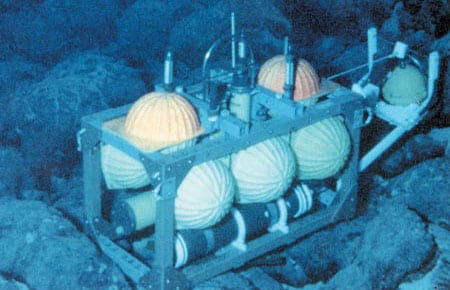
The Big MELT
The Mantle Electromagnetic and Tomography Experiment was the Largest Seafloor Geophysical Experiment Ever Mounted
1998— More than 95 percent of the earth’s volcanic magma is generated beneath the seafloor at mid-ocean ridges. As the oceanic plates move apart at spreading ridges, hot mantle rock rises from deep in the earth’s interior to replace material dragged away by the plates. This ascent releases pressure that had kept the hot mantle rocks solid. The mantle rock begins to melt and form basaltic magma, which then percolates up toward the surface through cracks and pores in the remaining solid, yet deforming, rock. At the ridge, the magma pools and solidifies to form a 6-to-7-kilometer-thick layer of new basaltic crust. This crustal layer underlies the seafloor throughout the ocean basins.
Most of what we know about this process of magma or melt production beneath ridges is inferred from the volume of melt indicated by the thickness of the crust and from the composition of basalts recovered at the seafloor by dredging, drilling, and submersible sampling. Much uncertainty remains about where and how the melt forms and is extracted from the mantle, because we have not had any means to directly probe into the melt production region tens to hundreds of kilometers beneath the earth’s surface.
Geophysical measurements, however, can provide means to probe deep into the mantle to detect the presence of melt or hot rock. For example, studying seismic waves that travel through the mantle can tell us something about the structure of the earth along their paths, because these waves travel slower in hot rocks and slower still if there are melt-filled cracks or pores. In addition, the forces of flow and deformation within the mantle often cause crystals of olivine or pyroxene, the most common minerals in the mantle, to align in particular directions. This phenomenon, in turn, speeds up or slows down the propagation of seismic waves through the crystals, depending on the direction and vibration of the waves. We can also extract information by analyzing the propagation of electromagnetic waves through the mantle, because basaltic melt is a better electrical conductor than solid rock. If the melt pockets are connected together to form a conducting network, the wave propagation is strongly affected.
In previous studies, scientists examined velocities of seismic waves traveling from their earthquake sources through ridges and to land-based receivers. They mapped regions of slow wave propagation near ridges, but found the data lacked the resolution to pinpoint the width or depth to which the region of melt production extends. That left room for two competing theories of how magma is generated beneath mid-ocean ridges: Some theoretical models predict that most of the upwelling and melting takes place in a narrow zone, perhaps less than 10 kilometers wide, directly beneath the ridge axis. In other models, melting extends over a broad region and the migrating melt is somehow forced back to the ridge axis to form new crust.
The Mantle ELectromagnetic and Tomography (MELT) Experiment was designed to distinguish between these competing theoretical models by investigating in detail the structure beneath a spreading center. In the largest deployment of geophysical instrumentation ever attempted on the seafloor, a total of nearly 100 ocean bottom seismometers (OBSs), electrometers, and magnetometers were placed in arrays across the East Pacific Rise (see map below). More than 50 scientists from 12 research institutions participated. The OBSs were supplied by groups from Woods Hole Oceanographic Institution and Scripps Institution of Oceanography (SIO), and electrometers and magnetometers by scientists from WHOI, Australia, France, and Japan. Beginning in November 1995, the seismometers recorded seismic waves generated by earthquakes around the world that propagated through the mantle beneath the ridge. In May 1996, the OBSs’ anchors were released and the instruments were recovered along with their valuable recordings. The same cruise that retrieved the OBSs also deployed the electrometers and magnetometers to begin a one-year period of recording electromagnetic waves generated by ionospheric currents that penetrate deep into the mantle.
The East Pacific Rise at 17°S was chosen for the experiment because it is in the middle of one of the longest, straightest sections of the mid-ocean ridge system and is spreading at close to the fastest rate, about 14.5 centimeters per year. In addition, the subduction zones of the Pacific Rim provided an excellent surrounding source of seismic waves, since earthquakes frequently occur in these zones, where the seafloor created at the East Pacific Rise eventually sinks back into the mantle. We were lucky that our six-month recording period was seismically active; there were several earthquakes of magnitude 7 or larger, as well as some good, smaller events on other parts of the East Pacific Rise. One of the best sources was an earthquake 150 kilometers deep in the Tonga subduction zone. We also happened to record the last three underground tests of nuclear devices in French Polynesia, but the signals from these explosions were too small to be useful for our purposes. During the deployment cruise, a group led by Robert Detrick and Pablo Canales from WHOI and John Orcutt and Sara Bazin from SIO employed an array of airguns towed behind the ship as artificial sound sources to acquire data on the structure of the oceanic crust (see Canales insert article below). Differences in crustal thickness are caused by variations in the supply of magma to the spreading center and thus provide additional information about the process of melt production in the mantle.
Seismic results from the MELT Experiment appear to have settled the long-standing debate about the form of the upwelling beneath the ridge. We found low seismic velocities through a zone several hundred kilometers wide, indicating the presence of melt at depths of 20 to more than 70 kilometers. This wide zone suggests that the separating plates provide the primary force that drives upward flow of the mantle beneath the East Pacific Rise. It contradicts the theory that melting occurs primarily in a narrow zone directly beneath the ridge and that upwelling of the solid mantle is driven and focused by buoyancy forces.
The seafloor begins to subside as it cools and moves farther from the ridge, but at the East Pacific Rise, it subsides more slowly on the western flank than on the eastern. This suggests that the mantle is hotter to the west. Nevertheless, we were surprised by the apparent asymmetry of the mantle structure, as evidenced by the seismic data. The low-velocity region extends as much as 250 kilometers west of the axis, but only about 100 kilometers to the east, and the lowest velocities may even be located west of the axis. Since there are also many more seamounts on the western, or Pacific Plate, side of the axis, the asymmetry may be related to melting and upwelling involved in the off-axis volcanism that builds seamounts. However, this volcanism is much less voluminous than that caused by the seafloor spreading process, producing only 1 or 2 percent of the oceanic crust in this area.
Another intriguing asymmetry was found by Cecily Wolfe (WHOI) and Sean Solomon (Carnegie Institution). One type of seismic wave, the shear wave, splits into two components that travel at different speeds in the upper mantle; shear waves go faster when vibrating in a direction parallel to the alignment of the crystals in the mantle—that is, when the waves’ vibrations are aligned with, rather than against, the crystalline grain. Wolfe and Solomon found that shear-wave splitting is twice as large beneath the Pacific Plate as beneath the Nazca Plate on the eastern flank, indicating that crystals may be better-aligned beneath the Pacific Plate. This difference may be caused by the different rates of plate motion; relative to the deep mantle, the Pacific Plate is moving twice as fast to the west as the Nazca Plate is moving to the east.
We have determined that the melting region, the region of anomalously low-velocity seismic waves, extends to depths of 150 to 200 kilometers beneath the ridge, although the velocity begins to increase and melt concentration decreases below about 100 kilometers (see figure at right). This depth is confirmed by modeling of the electromagnetic signals by Alan Chave and Rob Evans (WHOI) and Pascal Tarits (Université de Bretagne Occidentale, France), which indicates that the mantle may be conductive at depths of about 180 kilometers. This is important because petrologists and geochemists have long debated the depth to which melting extends. Some argue that most of the melting occurs at depths shallower than about 60 kilometers. Others suggest that as much as 40 percent of the melting must take place at depths of 70 kilometers or more, where pressures make the mineral garnet a common and stable crystal. Our results indicate that a significant amount of melting does occur in the garnet region, but it is difficult to say exactly how much. Probably no more than 1 or 2 percent of the mantle exists as melt anywhere beneath the ridge, even though the maximum degree of melting may approach 20 percent. The degree of melting can be much larger than the amount of melt present because melt migrates effectively through cracks and tubes toward the surface, removing the melt almost as fast as it is generated and leaving only a small concentration behind in the mantle matrix at any one time.
The MELT Experiment created a huge archive of geophysical data. It will probably take several years to complete analyses of this unique experiment and to create a new generation of models of mantle flow and melt production that will satisfy the many powerful constraints provided by these observations. Even the preliminary results described here, however, have significantly altered our understanding of seafloor spreading and the formation of the oceanic crust.
The MELT Experiment was funded by the National Science Foundation through the RIDGE Program.
Don Forsyth is a marine geophysicist and earthquake seismologist who concentrates on problems of plate tectonics: How thick are the plates? What drives plate motion? How do new plates form at mid-ocean ridges? Don graduated from the WHOI/MIT Joint Program in 1974 and has maintained connections with WHOI scientists ever since. He currently is chair of the Department of Geological Sciences at Brown University. His first research cruise was on R/V Chain out of Woods Hole. His latest was in the Indian Ocean studying interactions of hotspots and mid-ocean ridges. On shore, he loves playing squash and basketball.
Using Seismic Waves to “See” A Slice of the Oceanic Crust
J.Pablo Canales, Posdoctoral Guest Investigator,
Geology & Geophysics Department,
Woods Hole Oceanographic Institution
The primary source of seismic data for the MELT Experiment came from natural earthquakes. But a secondary data set was obtained using a large array of airguns aboard R/V Melville and 15 ocean bottom seismometers (OBSs). The airguns release into the water a bubble of air compressed to 2,000 pounds per square inch. When these bubbles pop they create a sound pulse that travels through the water, penetrates the solid earth several kilometers down through the crust and upper mantle, and eventually returns to the seafloor, where it is recorded by the OBSs. The physics of this phenomenon is basically the same as that which changes a light beam’s trajectory when it enters a different medium, such as a glass, or when it is reflected in a mirror. The velocity of the seismic waves through the earth’s multi-layered interior reveals a lot of information about its structure and composition.
The MELT Experiment was designed to determine the thickness of the ocean crust in the research area and its velocity structure (that is, how fast the seismic waves propagate through the crust at different depths). There were several important reasons to focus on the crustal structure:
1) Seismic waves originating at remote earthquakes travel through the earth and arrive at the OBSs after passing through the crust immediately beneath the instruments. Before seismologists can use seismic wave measurements to deduce the distribution of melt in the mantle, they must be sure that variations in oceanic crustal structure are not affecting their data.
2) Since the distribution of melt in the mantle affects its density, it also affects the local gravity field, so gravity measurements provide additional information with which to deduce how melt is distributed deep beneath the seafloor. But the gravity field is also affected by variations in the density and thickness of the oceanic crust. Once again, we must quantify and account for the crustal contribution to the gravity field before using gravity data to interpret the mantle.
3) In the area of the MELT Experiment, the Pacific Plate, west of the East Pacific Rise ridge, has far more abundant seamounts than the Nazca Plate, east of the ridge. Seismic measurements can help us to determine if the more abundant volcanism in the Pacific Plate is, as expected, associated with the formation of a thicker crust.
In our study we analyzed the travel times of three types of seismic phases. A single seismic wave generated from a single airgun shot consists of several phases, depending on the number of rock layers that it travels through. Pg rays are refracted within the crust; PmP rays reflect off the Moho (the mantle-crust transition); and Pn rays are refracted in the upper mantle (see figure at right). Respectively, these waves provide information on the speed of waves traveling through the crust, the thickness of the crust, and the speed of waves traveling through the mantle. We first obtained the crustal velocity structure using the Pg phase. Then, we obtained the average crustal thickness in four regions (at the center and end of a ridge segment in both the Pacific and Nazca plates) by matching the observed PmP and Pn travel times with travel times predicted by various models of crustal thickness. We tested a variety of models, changing the crustal thickness from 4 to 7 kilometers, and selected those that best fit the data.
Overall we did not find a resolvable difference in crustal thickness between the Pacific and Nazca plates. This implies that the asymmetries in depth and gravity measurements observed on each side of the ridge axis must be caused by density variations in the mantle, not the crust. Evidence for the asymmetry in mantle structure was observed in the teleseismic (waves from distant sources) data recorded on the same OBSs (see Forsyth article above). The crustal thicknesses measured along a primary array of OBSs were 4.8 to 5.6 kilometers on the Pacific Plate and 5.1 to 5.7 kilometers on the Nazca Plate. Along a secondary array, crustal thicknesses measured 5.4 to 6.2 kilometers on the Pacific Plate and 5.8 to 6.3 kilometers on the Nazca Plate. So the more abundant volcanism in the Pacific Plate is not creating a thicker ocean crust.
We did observe some smaller-scale, local differences in crustal thicknesses. The most noticeable and surprising one is in the Nazca Plate, where we found thinner crust along a line that crossed an inflated section of the ridge over a “melt lens reflector”—an image of the roof of a chamber, where magma has accumulated, and an indication of a robust magma supply. We found thicker crust along a line that crossed near the end of a ridge segment, where there is no magma lens or other indications of a large magma supply. The crusts in both areas are of similar age (0.5 million to 1.5 million years), but their thicknesses differ. Along with subsequent tectonic studies, this suggests that the configuration of the ridge has changed since those crusts were formed, moving crust from a volcanically active to an inactive location, and vice versa.
WHOI participants in the the MELT experiment were funded by the National Science Foundation. J. Pablo Canales was also supported by the Ministerio de Educación (Spain)/Fulbright Program.
Pablo Canales conducted his Ph.D. thesis at the Institute of Earth Sciences of Barcelona (Spain), studying the structure of the oceanic lithosphere affected by hotspots in “exotic” areas, such as the Canary Islands, Tahiti, and the Galápagos Islands. He first came to WHOI in 1996 as a guest graduate student and since April 1997 has been a postdoctoral guest investigator, funded by a grant from the Commission for Educational Exchange between the US and Spain (Fulbright Program) and the Department of Education of Spain. His research has focused on seismic studies of mid-ocean ridges, including the East Pacific Rise and the Mid-Atlantic Ridge.
Slideshow
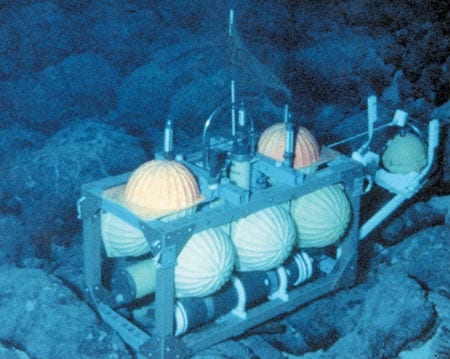
Slideshow
 An ocean bottom seismometer on the Pacific Ocean floor measures the velocity of seismic waves traveling through the mantle and oceanic crust. These data allowed scientists to probe deep within the portion of the earth that generates new ocean floor.
An ocean bottom seismometer on the Pacific Ocean floor measures the velocity of seismic waves traveling through the mantle and oceanic crust. These data allowed scientists to probe deep within the portion of the earth that generates new ocean floor.- A WHOI ocean bottom seismometer (OBS) is deployed from R/V Melville (Scripps Institution of Oceanography) at the start of the MELT Experiment in November 1995. Seismometers within the yellow spheres record ground motion generated by seismic waves traveling through the mantle and the oceanic crust. In May 1996, an anchor on the OBS was released and the instrument floated to the surface, where it was recovered.
- More than 50 ocean bottom seismometers (white triangles) were deployed across and along the East Pacific Rise off the west coast of Mexico during the MELT Experiment to probe the deep structure beneath the mid-ocean ridge. Arrows show the motions of the Pacific and Nazca plates, which are spreading in opposite directions from the ridge crest, shown by shallower depths (red)
- Initial results from the MELT Experiment are shown in this schematic cross-section of the upper mantle beneath the East Pacific Rise. The melting region below the mid-ocean ridge extends over a broad area several hundred kilometers wide. The region is asymmetrical, with a wider zone west of the ridge than east of it. The melting region also extends far deeper than many scientists have previously theorized: to depths of 150 to 200 kilometers beneath the ridge, although the greatest concentration of melt occurs above 100 kilometers.
- To measure the thickness of oceanic crust near the East Pacific Rise, WHOI scientists measured the velocity of airgun-generated seismic waves that travel through the crust, refract off rock layers, and are recorded by ocean bottom seismometers. A single seisimic wave from a single airgun shot consists of several phases, or rays, depending on the number of layers it penetrates. Pg rays (blue) are refracted within the crust and provide information on the speed of waves traveling through it. PmP rays (orange) reflect off the Moho (the mantle-crust transition boundary) and provide data on crustal thickness. Pn rays (green) are refracted in the upper mantle and offer data on the speed of waves traveling through the mantle. Only one of every 10 rays is plotted.

